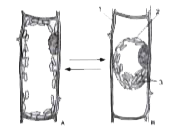Compare the cells kept in isotonic, hypotonic and hypertonic solutions.
To compare the cells kept in isotonic, hypotonic, and hypertonic solutions, we can break down the characteristics and effects of each solution on the cells as follows:
1. Isotonic Solution:
- Definition: An isotonic solution is one where the concentration of solutes outside the cell is equal to the concentration of solutes inside the cell.
- Effect on Cells: In an isotonic environment, there is no net movement of water into or out of the cell. The cell remains in its normal shape and size because the osmotic pressure is balanced. This means that the cell neither swells nor shrinks.
2. Hypotonic Solution:
- Definition: A hypotonic solution has a lower concentration of solutes compared to the inside of the cell.
- Effect on Cells: When cells are placed in a hypotonic solution, water moves into the cell due to osmosis (the movement of water from an area of higher concentration to an area of lower concentration). As a result, the cell swells and may eventually burst (lyse) if too much water enters. This process creates turgor pressure, which is essential for maintaining the structure of plant cells.
3. Hypertonic Solution:
- Definition: A hypertonic solution has a higher concentration of solutes compared to the inside of the cell.
- Effect on Cells: In a hypertonic environment, water moves out of the cell into the surrounding solution. This leads to the cell shrinking (crenation in animal cells), as it loses water. In plant cells, this can cause the cell membrane to pull away from the cell wall, a process known as plasmolysis.
Summary:
- Isotonic Solution: No net movement of water; cell remains the same size.
- Hypotonic Solution: Water enters the cell; cell swells and may burst.
- Hypertonic Solution: Water exits the cell; cell shrinks.
- Definition: An isotonic solution is one where the concentration of solutes outside the cell is equal to the concentration of solutes inside the cell.
- Effect on Cells: In an isotonic environment, there is no net movement of water into or out of the cell. The cell remains in its normal shape and size because the osmotic pressure is balanced. This means that the cell neither swells nor shrinks.
- Definition: A hypotonic solution has a lower concentration of solutes compared to the inside of the cell.
- Effect on Cells: When cells are placed in a hypotonic solution, water moves into the cell due to osmosis (the movement of water from an area of higher concentration to an area of lower concentration). As a result, the cell swells and may eventually burst (lyse) if too much water enters. This process creates turgor pressure, which is essential for maintaining the structure of plant cells.
- Definition: A hypertonic solution has a higher concentration of solutes compared to the inside of the cell.
- Effect on Cells: In a hypertonic environment, water moves out of the cell into the surrounding solution. This leads to the cell shrinking (crenation in animal cells), as it loses water. In plant cells, this can cause the cell membrane to pull away from the cell wall, a process known as plasmolysis.
- Isotonic Solution: No net movement of water; cell remains the same size.
- Hypotonic Solution: Water enters the cell; cell swells and may burst.
- Hypertonic Solution: Water exits the cell; cell shrinks.
Topper's Solved these Questions
- TRANSPORT IN PLANTS BOOK - ICSECHAPTER - TRANSPORT IN PLANTS EXERCISE - REVIEW QUESTIONS (Give reasons for the following)
5 Videos
- TRANSPORT IN PLANTS BOOK - ICSECHAPTER - TRANSPORT IN PLANTS EXERCISE - REVIEW QUESTIONS (Miscellaneous questions with answers)
15 Videos
- TRANSPORT IN PLANTS BOOK - ICSECHAPTER - TRANSPORT IN PLANTS EXERCISE - REVIEW QUESTIONS (Short answer type questions)
25 Videos
- THE LIVING WORLD BOOK - ICSECHAPTER - THE LIVING WORLD EXERCISE - Ncert Exercises (Differentiate Between )
4 Videos
Similar Questions
Knowledge Check
Statement 1: Plasmolysis is bursting of cell membrane when a cell is kept in a hypertonic solution.
Statement2: Hypertonic solution causes endosmosis.ABoth statements 1and 2 are corect.BStatement1 is correct but statement 2 is incorrect.CStatement 1is incorrect but statement 2 is correct.DBoth statements 1 and 2are incorrect.A cell placed in hypertonic solution will :
AShrinkBShow exosmosisCShow endosmosisDNo change in size and shape
Correct the statements.
(a) Cells shrink in hypotonic solutions and swell in hypertonic solutions.
(b) Imbibition is a special type of diffusion when water is absorbed by living cells.
(c) Most of the water flow in the roots occurs via the symplast.
View SolutionIn the given figures 'A' shows a cell in the normal state and 'B' shows the same cell after leaving it in a certain solution for a few minutes :

Was the solution isotonic, hypotonic or hypertonic in which the cell was kept ?
View SolutionGive technical terms for the following:
Movement of water molecules across the cell membrane from hypertonic to hypotonic solution.
View SolutionWhat are isotonic solutions?
View SolutionSelect the correct answer out of the four available choices given under question :
The space between the cell wall and plasma membrane in plasmolysed cell is filled with:
(i) isotonic solution
(ii) hypotonic solution
(iii) hypertonic solution
(iv) water
View SolutionDifferentiate between the following pairs on the basis of what is mentioned in brackets:
Hypotonic solution and Hypertonic solution [condition of a plant cell when placed in them]
View Solution
